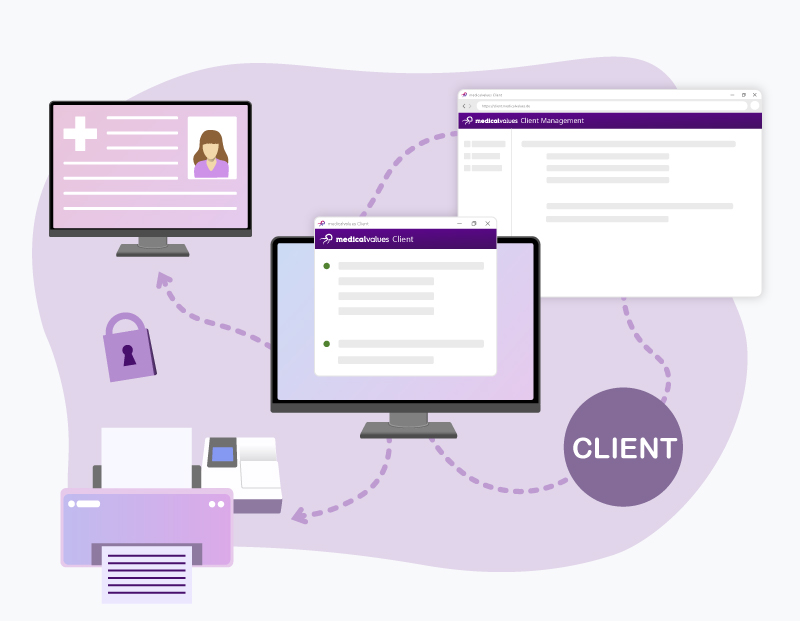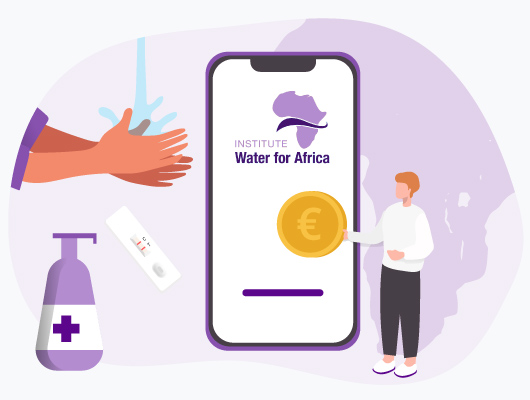Many processes (e.g., electronic laboratory orders) can now be fully digitized, yet the networking of systems and data often poses a challenge, leading to increased effort and dissatisfaction among users in clinics and practices, manufacturers, and IT experts.
medicalvalues has developed a specialized client solution to address these obstacles and create added value. Our client module enables physicians to extract data from their system in a structured way and use it efficiently.
The medicalvalues Client
The medicalvalues Client offers a wide range of functions and is primarily used for data integration into various systems, such as practice management systems, as well as for centralized configuration and management.
The medicalvalues Client solution consists of two main components:
Client Management: Online access for the central configuration and management of various settings (e.g., practice-wide printer connection or data distribution).
Local Client: The locally installed application enables data integration and transmission in the practice management system (PMS).
The client is available either individually or in combination with other medicalvalues applications, such as medicalvalues Order Intelligence.
Use Cases with the medicalvalues Client
The medicalvalues Client is versatile and supports a wide range of processes and applications by linking and utilizing patient data in PMS or hospital information systems (HIS): from lightweight connection of Order Entry systems to data extraction for research and clinical studies.
Order Entry System
- A new order is created in the PMS
- The client transmits the patient information for order creation to the Order Entry system.
- The order is assembled in the Order Entry system.
- The print job for the required labels and documents is sent to the printer via the client.
- The order information of the submitted order is sent to the PMS, and the report information is sent once available.
POCT
A POCT analysis is performed.
The result of the analysis is sent to the device workstation and processed.
The result is transmitted to the HIS (or LIS or PMS) via the clients.
Study recruitment
- The client transmits patient information for eligibility screening from various source systems (e.g. PMS from different manufacturers).
- The study recruitment software matches the data.
- Matches are displayed as push notifications on the practice computer via the client.
Patient Portal
- A new patient is created in the PMS.
- Patient data is sent to the patient portal via the client.
- Automatic printing of a QR code and access information for the patient.
- The patient fills out a form (e.g., initial medical history) in the patient portal.
- The completed form data is sent back to the PMS.
The Practical Implementation
The primary goal is to offer a cost-effective, scalable, highly stable, and at the same time flexible solution for various scenarios, providing physicians with added value in patient care. We take the following aspects into account:
1. Data integration into existing systems: Since physicians spend most of their time in the PMS/HIS, the depth of integration is crucial. In Germany, integration is often file-based (e.g., via LDT interfaces), while in Switzerland, hybrid forms with “real APIs” are also common. The client is compatible with all common practice management systems (e.g., tomedo, medatixx, inSuite, CGM Medistar, SMR, E-PAT, or Elexis).
2. Standards: We rely on internationally recognized standards (e.g., SNOMED CT and LOINC), supporting various data formats and also addressing local requirements (e.g., DiMuS, KIM, MIOs, etc.).
3. Centralized Management: The medicalvalues Client Management enables modern management and configuration (e.g., of printers and directories to be monitored).
4. Simple Installation: The client can be installed locally on the users’ computers via an installation file. This can be done remotely by the team or by the end users themselves.
5. Cross-platform Availability: The medicalvalues Client is compatible with various operating systems and runs on Windows, iOS, and server-based systems.
6. Maximum Stability: The programming language Rust ensures a modern and robust application.
7. Expandability: Our modular system is flexibly expandable and can be adapted for various use cases, such as the interface for scanning documents. You can find more information here: (Un-)structured data in electronic health records: From digital scanning to medical information source – medicalvalues.
The medicalvalues Client is a lightweight and modern solution for centralizing processes and linking data. It runs robustly, is easily scalable, and offers maximum flexibility regarding the environment and use case.




